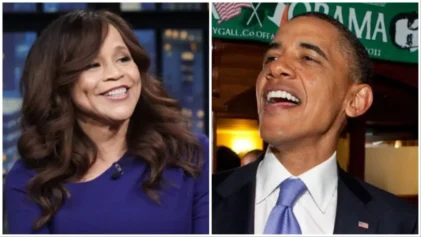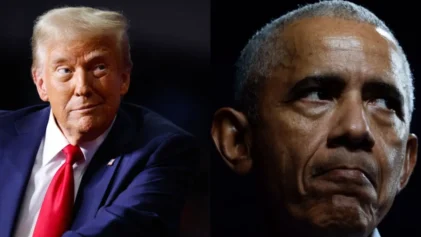
While the militarization of police has been a serious problem for a long time, it wasn’t until armored vehicles and sniper rifles filled the streets of Ferguson, Mo., that many Americans realized just how serious the problem really was.
So the new ban certainly seems like an admirable step forward for the Obama administration but it is, of course, another move that will place the president in the middle of an ongoing game of tug-o-war.
Throughout the final years of his presidency, Obama has been left fielding criticisms from two populations that are currently at the center of a national stage—law enforcement and the Black community. Both populations have been tugging at the president, urging him to be more supportive of their cause.
As a Black man himself, he is expected to fully back the Black community and understand their plights and hardships. As the leader of a nation, he has been heavily criticized for coming off as “anti-police,” even as many residents claim he has still been too lenient with law enforcement.
But as he made his way to Camden to announce a variety of new measures aimed at repairing the severely damaged relationship between Black communities and the police, he pointed to the New Jersey city as a blueprint for others to follow.
“The reason the Obama administration chose the New Jersey city as the site of the president’s big law enforcement speech is that it is seen by policymakers as a model for how a worthless and dysfunctional police department that is hated by residents can be turned into a force for good,” writes Slate’s Leon Neyfakh.
Camden has a troubled history that left it with a disconcerting reputation as one of the most dangerous cities in the entire country. A serious overhaul of the police department, however, has caused crime rates to plummet, has drastically cut down on a once staggering murder rate and has helped slow the once gushing flow of illegal guns into local communities.
“According to statistics from last August, shootings had fallen 43 percent over two years, and violent crime more generally was down 22 percent,” Neyfakh explained. “The number of murders went from a record 67 in 2012 to 54 in 2013 to 32 last year.”
The sudden changes have been attributed to a decision made by city officials back in 2012 to actually disband Camden’s police department and move in county-level officers to take their place. The difference, city officials noted, was the lack of expensive union contracts that made it a serious financial burden to even keep officers around.
So as the city launched a massive wave of layoffs, the policing landscape in the city almost immediately started to change and hundreds of non-unionized officers were now patrolling one of the country’s most impoverished communities.
It resulted in a force that was comprised of more than 200 additional officers, although the city didn’t have to make any changes to its budget. According to a report by The New York Times, police response time in the city was slashed from nearly an hour to less than five minutes.
While the situation in the city is far from perfect, the amount of change that has taken root in just a few years is, in the president’s opinion, a source of inspiration for communities all across the country.
As he addressed the crowd of roughly 300 people at the Salvation Army’s Ray & Joan Kroc Corps Community Center on Monday, President Obama hailed the city as a “symbol of promise for the nation.”
He added that even the work in Camden is far from done and referred to the efforts as a “work in progress” but he also built on the fact that the city was evidence of change and perhaps proof that eventually the relationship between Black and low-income communities and police officers can be mended without neglecting the needs of either party.
One social worker described Camden to The New York Times last year as a “different place” where “police officers aren’t afraid to come out of their cars and interact with the community” before adding that that new environment is exactly what has “changed how people feel about them.”
But the game of tug-o-war is far from over.
Law enforcement officials still feel as if the president is unfairly taking aim at officers while even some residents in Camden are not satisfied with the changes that are currently being praised as an example for police departments everywhere.
“The American Civil Liberties Union’s New Jersey branch expressed concern on Monday that the shift in Camden has been toward more arrests and tickets for low-level offenses such as riding a bicycle without a bell or lights, disorderly conduct and failure to maintain lights on a vehicle,” The New York Times reported. “And of the 65 complaints last year accusing the police of using excessive force, about two-thirds were dismissed by the department.”
Those types of changes could very well “create a climate of fear, rather than respect,” Udi Ofer, the executive director of the New Jersey branch of the ACLU told the New York Times.
Meanwhile, the national president of the Fraternal Order of Police, Chuck Canterbury, is insisting that there isn’t enough trust in law enforcement while accusing the president of making accusations of poor policing “without knowing the facts.”
A senior advisor to the president, Valerie Jarrett, countered that the president has never placed all the blame on police officers and even noted that he has praised law enforcement on several occasions. He even sung praises of their courage as he addressed the crowd in Camden.
“To be a police officers take a special kind of courage,” he said. “We can’t ask the police to contain or control problems that the rest of us aren’t willing to face or do anything about.”
It’s yet another statement from the president that seems to be supporting the idea of a collaborative effort between police and the communities they serve in order to mend the rapidly growing rift between them.
But it is an approach that may be difficult to see manifest as both communities have varying opinions on the president’s latest move yet again.
Most communities are applauding the president for the new ban on military style weapons for local police departments, noting that having that kind of artillery only adds fear and fosters mistrust. Canterbury, however, says it’s just another example of the president picking sides instead of fixing issues.
“Putting those on restricted lists and making it so you’re going to have to justify having that equipment gives the connotation that the police shouldn’t have that protection,” he added. “The fact is, a riot can happen in any city in America.”
Of course, riots have already happened in cities across America. It wasn’t until cases like Ferguson, however, that an American city suddenly looked like a foreign war zone.
The new regulations on such weaponry is aimed at making sure there are no more racially biased deployments of armored vehicles and assault rifles that are being placed up against a bunch of protesters with an artillery of rocks, bottles, and cardboard signs.


